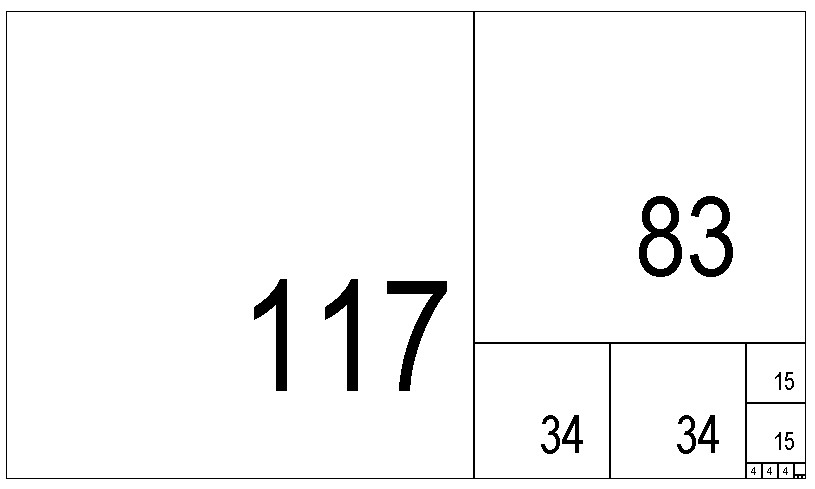A ratio, e.g. 200/117, is represented as a 200×117 rectangle. Operation of the Euclidean algorithm or the jigsaw method gives the continued fraction [1;1,2,2,3,1,3].

On this page, variables are positive integers. Rectangles ![]() are drawn only for
are drawn only for ![]() , but usually in the text, only the proper fractions with
, but usually in the text, only the proper fractions with ![]() are given, to save space (and these lie conveniently between 0 and 1.) But remember, the rectangle
are given, to save space (and these lie conveniently between 0 and 1.) But remember, the rectangle ![]() represents both
represents both ![]() and
and ![]() e.g. where
e.g. where ![]() appears below,
appears below, ![]() also has the same number and size of constituent squares, it is just rotated
also has the same number and size of constituent squares, it is just rotated ![]() (which here = inversion).
(which here = inversion).
1 size
1 square alone is ![]() or
or ![]() .
.
Putting 2, 3, 4… squares next to each other, we have the numbers 2, 3, 4.. or, looking from the ![]() direction,
direction, ![]() ,
, ![]() ,
, ![]() …
…
i.e. numbers of the form ![]() and
and ![]()
In order of magnitude: ![]()
Or, from the ![]() direction,
direction, ![]()
N.B. From here on I will omit all mention of the half of the fractions ![]() , except in the general formulas, to save space. For every
, except in the general formulas, to save space. For every ![]() mentioned,
mentioned, ![]() is in the same group.
is in the same group.
2 sizes
Using 1 large square and smaller ones along the side, we get ![]()
[illustrate]
Using 2 squares and smaller ones along the side, ![]()
[illustrate a few]
Using 3 and smaller ones, ![]()
[show a few]
i.e. numbers of the form ![]() (and
(and ![]() ), where
), where ![]() .
.
[show diagram of general case]
In order of magnitude:
![]()
![]()
[picture of plot of these on number line, ![]() , each a short vertical line, maybe pic width 500px]
, each a short vertical line, maybe pic width 500px]
3 sizes
Working backwards, this group is made up of each of the previous group, with 1 or more squares stuck on to the side.
From the “2 sizes, 1 large square group”:
![]() with 3×3 squares added makes:
with 3×3 squares added makes: ![]()
![]() with 4×4 squares added makes:
with 4×4 squares added makes: ![]()
![]() with 5×5 squares added makes:
with 5×5 squares added makes: ![]() etc.
etc.
4 sizes
Functions
Define:
![]() the number of Different-sized squares needed to construct
the number of Different-sized squares needed to construct ![]() .
.
![]() number of iterations of Euclid’s algorithm to find
number of iterations of Euclid’s algorithm to find ![]()
![]() number of terms
number of terms ![]() in the continued fraction.
in the continued fraction.
![]() the total Number of squares needed to construct
the total Number of squares needed to construct ![]() , regardless of size.
, regardless of size.
![]() sum of the continued fraction terms
sum of the continued fraction terms ![]() .
.
![]() total of the numbers
total of the numbers ![]() used as multipliers
used as multipliers ![]() in Euclid’s algorithm.
in Euclid’s algorithm.
If a/b is irrational, ![]() is infinite, e.g.
is infinite, e.g. ![]() . Although e.g. for
. Although e.g. for ![]() = VALUE*#*#*#?!?,
= VALUE*#*#*#?!?, ![]() but
but ![]() .
.
[picture of Stern-Brocot tree, ![]() , with D() and N() next to each number. width =500px?]
, with D() and N() next to each number. width =500px?]
=== state rules for D and N for S-B tree. and for adding fractions generally.
=== make table of D and table of N for a=1…50 and b=1…50 .. or 30, whatever fits on a page.
===could do a table 100×100 with dots in each square representing D(a/b).. or colour coded.. could go higher.
=== what WOULD that look like?! 🙂 or even 500×500, 2 pixel colour in each one… 250×250 maybe better.
=== How many fractions have ![]() =1,2,3..? is is Catalan numbers or something?
=1,2,3..? is is Catalan numbers or something?
=== Make another page for the 3D case!!